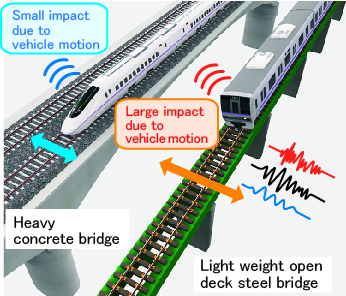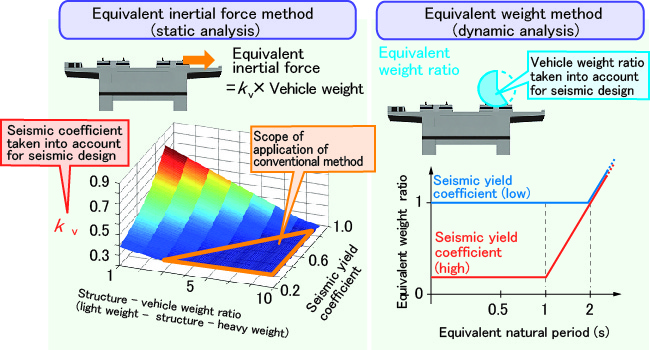1. Simplified method for evaluating vehicle motion effect on seismic response of railway structure
- Numerical analyses evaluated amplification effects and damping effects induced by vehicle motion on the seismic response of structures.
- A simplified method for estimating the seismic response of structures in consideration of the effect of vehicle motion was proposed.
There is a possibility that vehicle vibrations will influence a structural response during large scale seismic motion. However, to date there is no clear data to support this idea. As a result numerical analyses were conducted taking into account the dynamic interaction between vehicles and structures, and measurements were taken of vibrations on a real viaduct, resulting in a proposal for a high-precision and simplified assessment method to determine a structure’s seismic response.
The numerical analysis quantified the elements constituting structure response during earthquake, such as type of vehicle and its speed, the equivalent natural period and yield seismic coefficient of the structure, structure/vehicle weight ratio, the predominant period of the seismic motion (Fig.1). The combination of all these elements produces a very complex picture of the dynamic interaction between the structure and the vehicle, however, in simple terms two movements can be identified: the vehicle and structure are moving either in the opposite direction or in the same direction. It was determined that the former produces a vibration damping effect, whereas the latter generates a vibration amplification effect (Fig.2).
A simple estimation method was proposed which can be used for practical structure design. Aimed at ordinary seismic design (static analysis), the proposed ‘equivalent inertial force method’ uses the structure/vehicle weight ratio and seismic yield coefficient of the structure while inertial force is taken to assess the impact of the vehicle vibrations. In order to address the specific characteristics of very long bridges or other special structures, (dynamic analysis), another method was proposed. This the equivalent weight method takes into account the above mentioned underlying elements and the structure’s natural period and other factors which must be considered in design, such as the estimated vehicle weight ratio (equivalent weight rate). This weight is added to the structure to create a simple model to assess the impact of the vehicle’s vibrations (Fig.3).
The resulting ability to accurately calculate the seismic response of structures will make it possible to perform high-precision and economically viable diagnoses of existing structures.

Fig.1 Dynamic interaction between structures
and railway vehicles during earthquake
Fig.2 Mechanism by which vehicle motion influence structures
Fig.3 Seismic design method taking into account vehicle motion